Homemade Dish Soap Recipe || The Truth About Making Your Own
The truth about homemade dish soap is hard to come by on the net. There are a ton of recipes out there for this handmade natural cleaning product, and they all claim that it performs better than commercial versions.
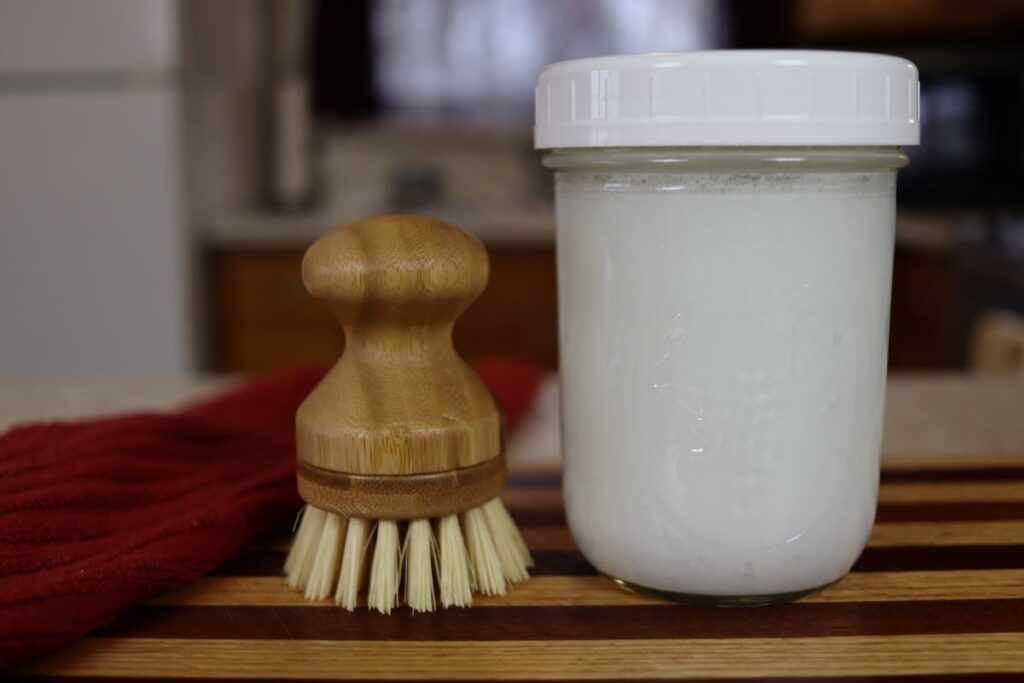
But do they, really? Well … I suppose that depends on how it is that you’re assessing them.
So, today I’d like to share how I assess them with you. The good, the bad, and the ugly, as they say. AND, I’m going to share the recipe that I use for my homemade dish soap too.
It’s inexpensive, it’s effective, and as far as I’m concerned, it’s really the only recipe to use.
Why You Should Make Homemade Dish Soap
But first, let’s talk a bit about why you should even bother making your own homemade dish soap. After all, there are plenty of pre-made products sitting right on the grocery store shelves for your convenience.
But, the ingredients in those products are toxic. Not only for the environment but for you as well. The entire time your washing your dishes, you are submersing your hands in a sink full of chemical soup.
Commercially produced dish soap often contains ingredients that have been linked to many health concerns; including vision damage and cancer.
Formaldehyde, triclosan, sodium borate, and sulfuric acid are just a few of these ingredients.
But, before you check out the ingredients listed on your commercial dish soap bottle, know this … there are no regulations requiring manufacturers to list ingredients on their products.
That’s right. They don’t have to disclose the ingredients in their products by law. But they know that consumers like to see ingredients on the labels of the products they buy, so they use umbrella terms to satisfy them.
These terms include fragrance, preservative, surfactant, colorant, and cleaning agent.
So, considering how unhealthy store bought dish soap is for you, your family, and the environment, you really do want to make your own.
Does This Product Work The Same As Commercial Dish Soaps?
Homemade dish soap definitely does not work the same as commercial dish soap. As a matter of fact, it is quite different, and it can take a little getting used to using it.
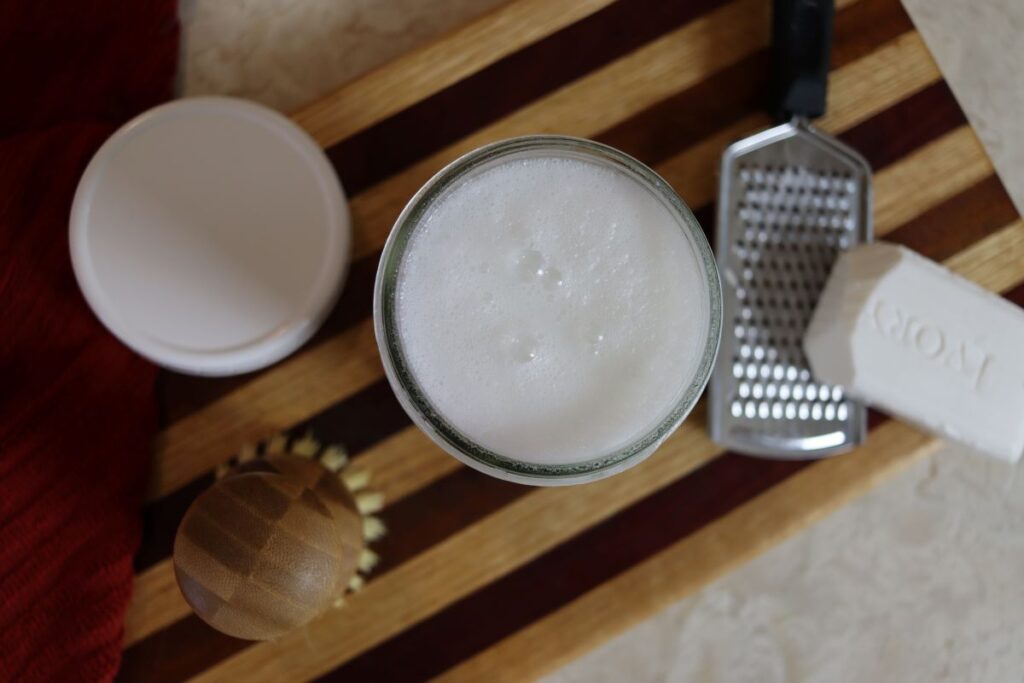
Difference #1 …
The thing that it seems most people have the hardest time adjusting to is the fact that homemade dish soap doesn’t bubble like commercially produced products do. Because of this, many diy recipes use a product called sal suds.
There is a lot of controversy about this product, because it contains sodium lauryl sulfate. This is an ingredient that you can do your own research on, and draw your own conclusions.
I don’t use sal suds. I do, however, use castile soap. And that is another ingredient that will give homemade dish soap some bubbling action. It doesn’t give it much though, and the cost of making dish soap with it is prohibitive, at least in my opinion.
So I skip the suds, and with good reason. You see … foaming agents do not contribute to the effectiveness of cleaning products at all. They are included in the products to give the impression that the product is working, because we have been conditioned to expect them.
Not even kidding. Bubbles are completely unnecessary, and the ingredients used to create them are questionable at best.
Difference #2 …
The other noticable difference between diy dish soap and commercial brands is that they are thinner. There are ways that you can thicken your handmade products. For this post, I added salt to my recipe for the very first time.
It thickens the dish soap nicely. Although, it doesn’t get the same consistency as commercial products. It forms a gel like ‘plug’ that sits on top of the jar. So, it needs to be stirred before you use it.
I’m happy with the results, but it does eliminate the ability to put it in a jar with a pump. a little.
However, with all that said, I’m not going to try to convince you that homemade soap works as effectively as commercial brands, because they don’t.
So, you have to decide for yourself whether or not the trade off of having a chemical-free product is worth the extra elbow grease you’ll have to apply when using it.
For me, it is totally worth it. I have no desire to soak my hands in a sink full of chemicals every time I wash dishes.
Would you like to save this post for later?
Ingredients Needed To Make Homemade Dish Soap
I keep the ingredients that I use in my homemade dish soap simple and easily accessible. You likely already have them at home.
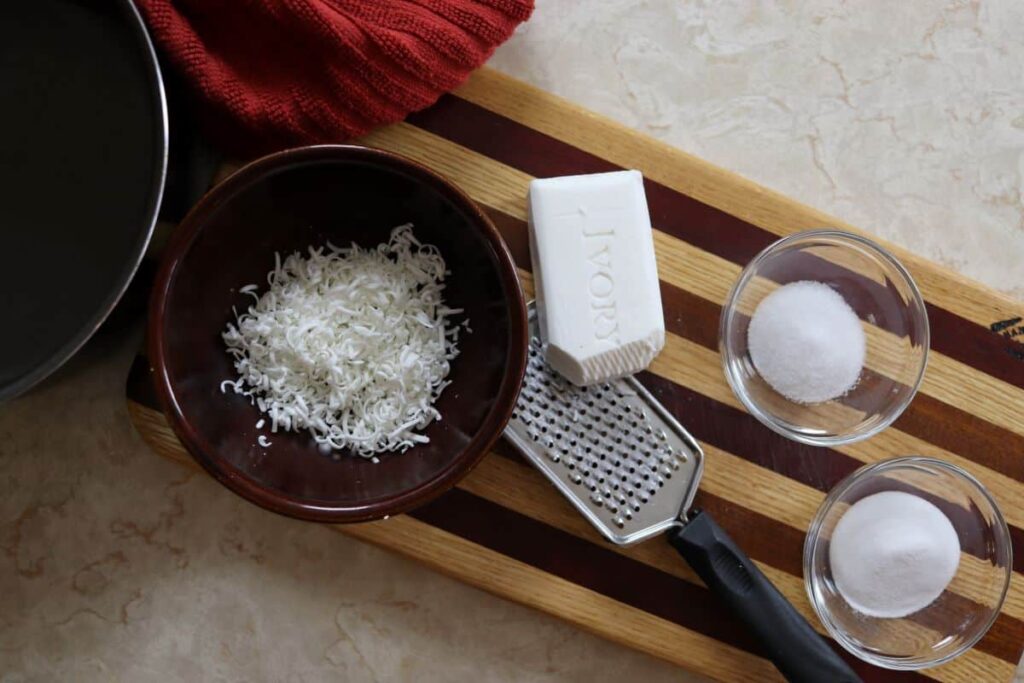
Here’s a list of them for you …
- WATER – You will need water that is hot enough to melt the bar soap for this recipe. Yet, you don’t necessarily want to heat it to boiling.
- BAR SOAP – I use ivory soap for this recipe. It is 99.44% chemical free. When I used to make my own bar soap I used that. But I am not doing that right now, and ivory is a decent option. Still, it would be better to use a 100% chemical-free handmade bar. So, if you’ve got ’em, use ’em.
- BAKING SODA – Baking soda is used in this recipe to cut grease. It is an excellent product for that purpose. If you feel that it leaves a residue on your dishes you can substitute white vinegar for it in your soap.
- SALT – A little bit of salt is used to thicken the recipe a bit. This is primarily an aesthetic issue. The salt is completely optional. But it’s so darn cheap that you might as well throw it in there.
Adding Essential Oils To Your Recipe
I do not add essential oils to my homemade dish soap. Although, they are a nice addition if they’re important to you.
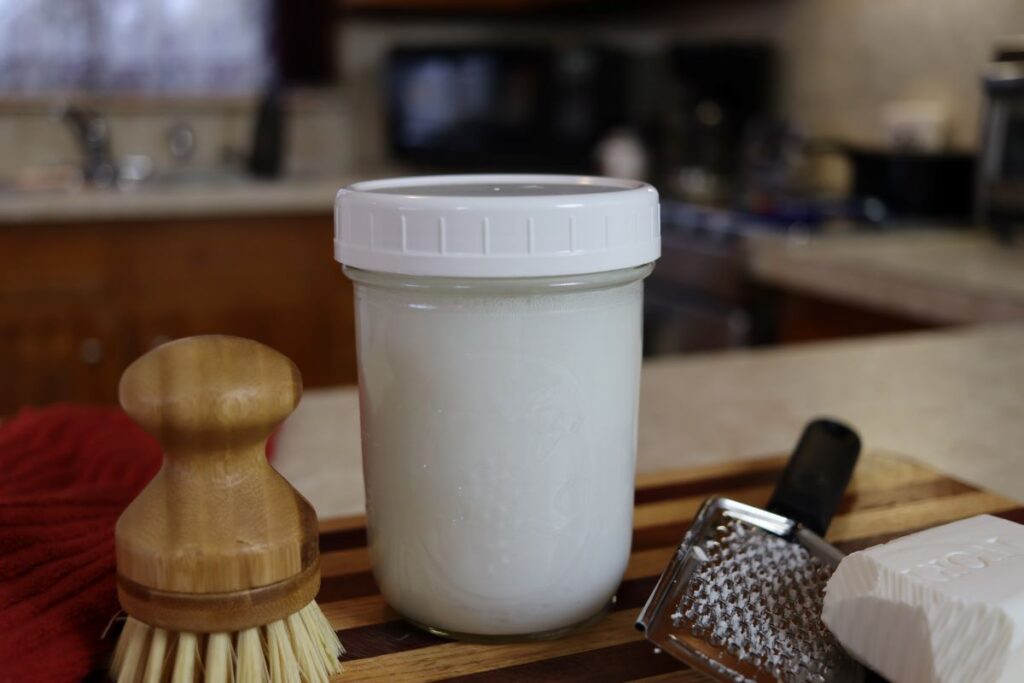
They primarily provide a pleasant scent to the product. And as I’ve stated about other cleaning products that I’ve written posts on, while they have properties that could potentially contribute to the effectiveness of the dish soap, the shear volume that you would need for that to be a real thing is unreasonable.
However, when it comes to this particular recipe, they can be a pleasant addition. They emit a nice fragrance when they are added to hot dish water. And there are no other ingredients in the recipe that drown that fragrance out.
So, choose your favorite fragrance, and add them if you like. Lemon, eucalyptus, and lavender are just a few of the many choices available out there.
How To Make Homemade Dish Soap
You’ll need to grate the bar soap to make this homemade dish soap recipe. And then place it in a saucepan with the water, and put it on the stovetop over medium heat.
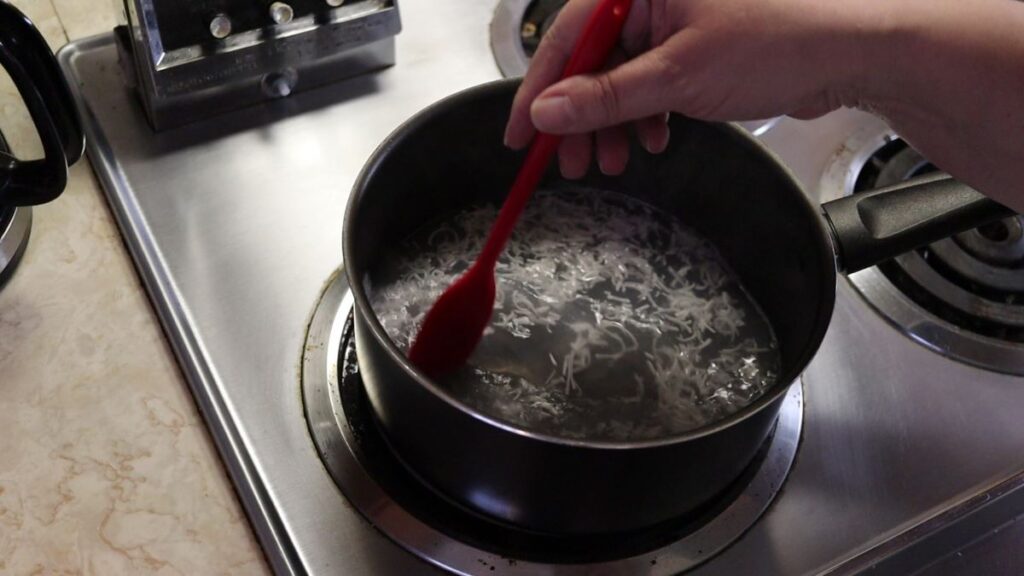
Stir it consistently, and don’t allow it to come to a simmer. If you have to remove it from the burner for a bit to prevent it overheating, go ahead and do so.
Allow the mixture to heat until all of the soap is melted. And pour it into the vessel you plan to store it in, provided the mouth is large enough to continue to add ingredients.
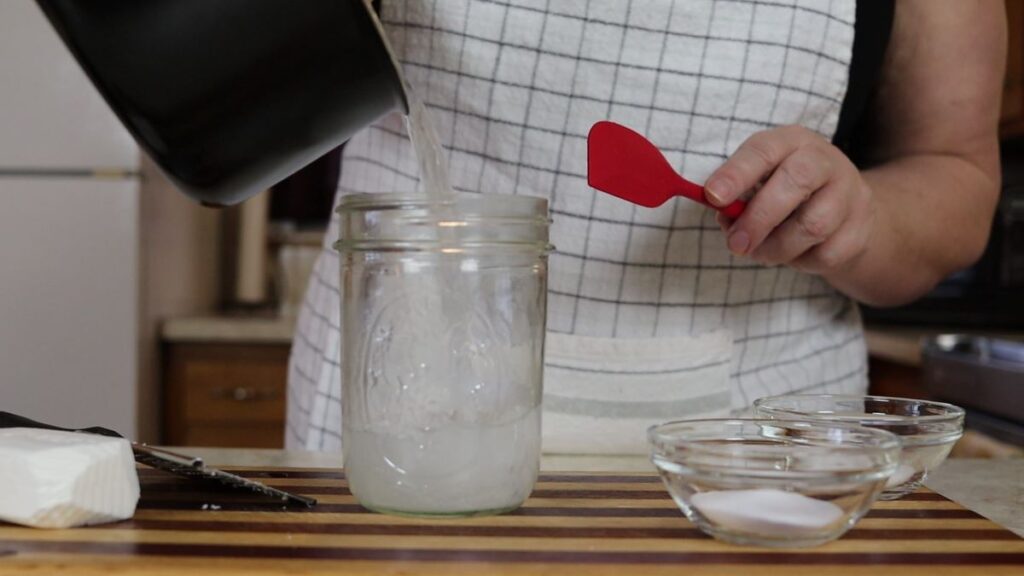
Then stir in the baking soda and salt, and allow the mixture to cool. Place the lid on the container and you’re all set, you’ve got a batch of chemical-free dish soap.
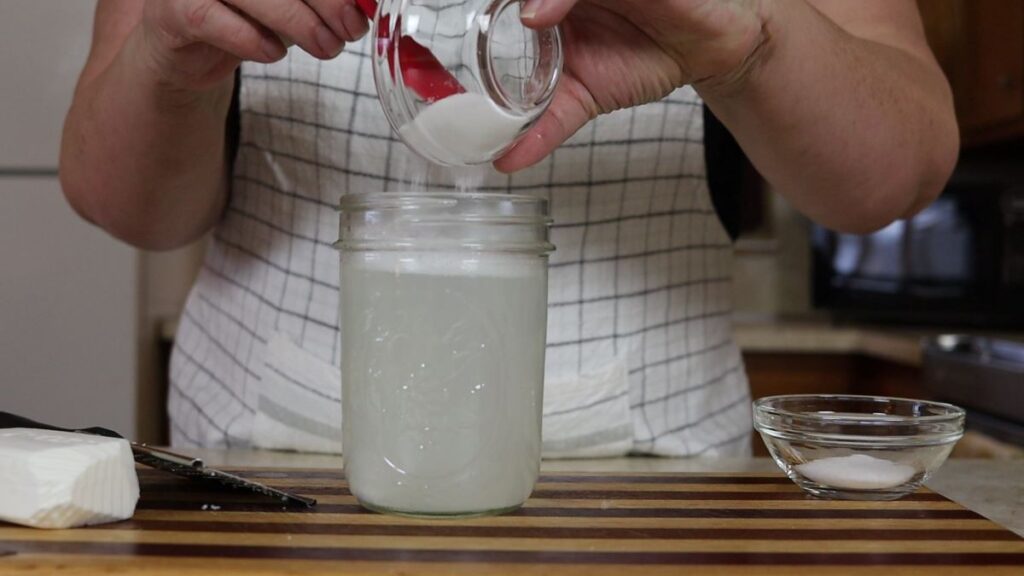
How To Use This Product
You can get the most out of your homemade dish soap by following a few simple guidelines when using it.
First, don’t allow your dishes to sit and develop stuck on food residue, wash them right away. You may even want to rinse them before you begin to fill your sink with wash water.
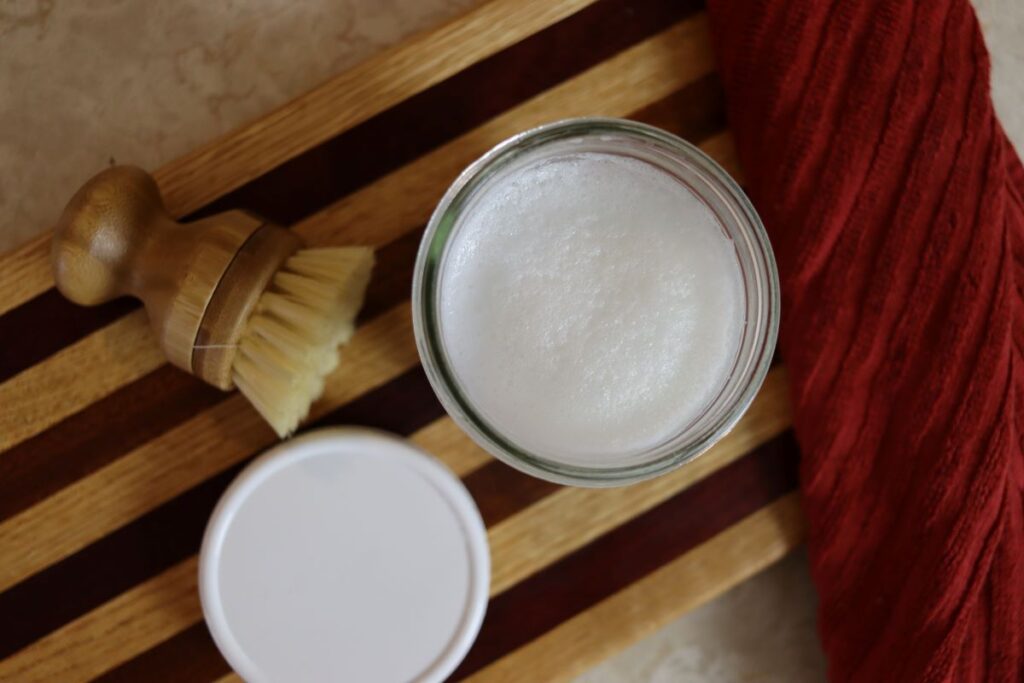
If your dishes do have a considerable amount of stuck on food residue, consider soaking them in a sinkful of water with some white vinegar added to it. This option works well, but can get pricey if it becomes a regular practice. I generally only use this method when dealing with dishes from large gatherings.
Second, don’t fill the sink all the way when using this diy cleaning product. Put just 4 or 5 inches of water in the sink at a time.
I find that this is often enough to wash all of my dishes. And when there are more dishes than usual, I simply repeat the process when the water gets too dirty.
And finally, you will find that using a dish brush to scrub your dishes may sometimes be necessary when using this soap.
A dishcloth may not be effective enough. And a sponge will work, but they tend to harbor a great deal of bacteria. So, it’s really best to just pick up a dish brush and avoid all those messy germs.
Recommended For You
If you try this recipe and love it, please give it 5 stars! It supports my work more than you may realize, and I appreciate that a great deal!
You can also show your support by tagging me on Facebook @sustainableslowliving and/or Instagram @slowlivingbydianegail when you post a pic of your finished soap.
Homemade Dish Soap
Equipment
- Kitchen rater
- Measuring cups and spoons
- Small saucepan
- Spatula or wooden spoon
- Jar with a lid
Materials
- 2 cups water
- 1/4 cup natural bar soap grated
- 1 tbls baking soda
- 2 tsps salt
Instructions
- Combine base: Add water and grated bar soap to a saucepan and place over medium heat.
- Melt soap: Stir constantly until the soap is completely melted. Do not allow the mixture to simmer.
- Remove from heat: Once the soap has melted fully, take the pan off the heat.
- Transfer to container: Pour the hot liquid into a jar.
- Add dry ingredients: Stir in the baking soda and salt until fully dissolved.
- Cool completely: Let the mixture sit uncovered until it reaches room temperature.
- Stir before use: Shake before each use, as natural separation may occur.
Video
Notes
- Use natural bar soap only: Choose a bar soap made with clean, recognizable ingredients — avoid synthetic fragrances, dyes, or detergent-based bars.
- Grate soap finely: Finer shreds melt faster and blend more smoothly into the water.
- Stir continuously: Keep the mixture moving to prevent clumping or uneven melting.
- Let cool uncovered: This prevents excess moisture buildup inside the jar and helps the mixture set properly.
- Storage: Store in a lidded jar at room temperature and shake before each use, as some separation is normal.
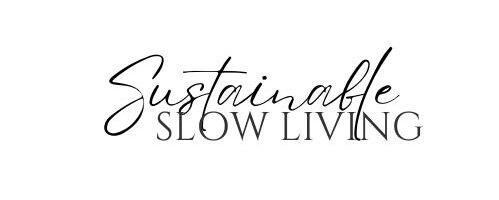

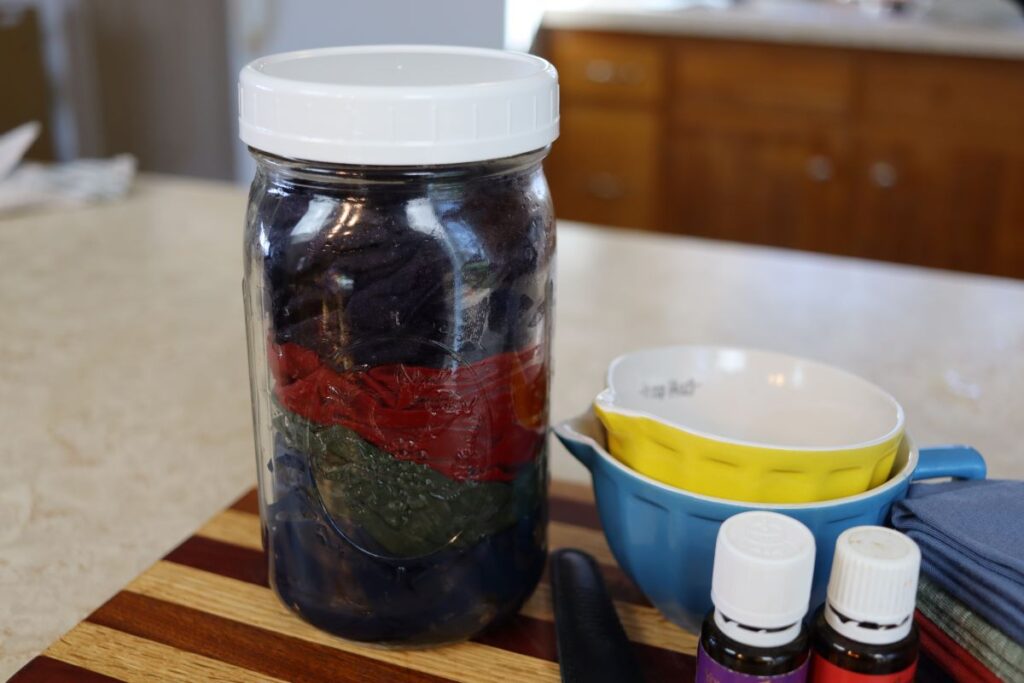
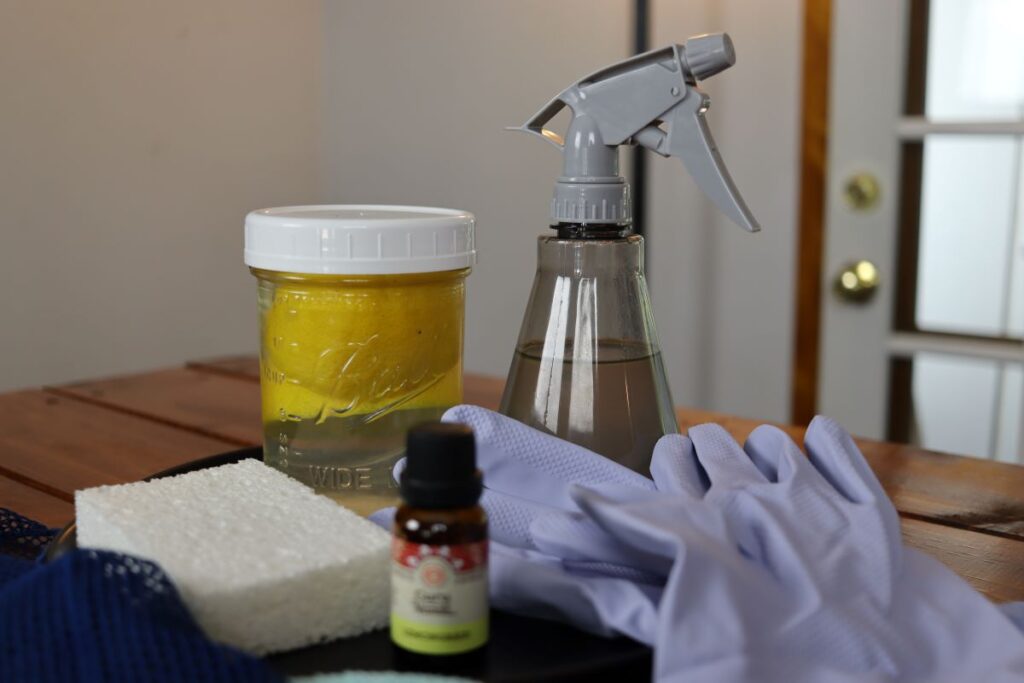
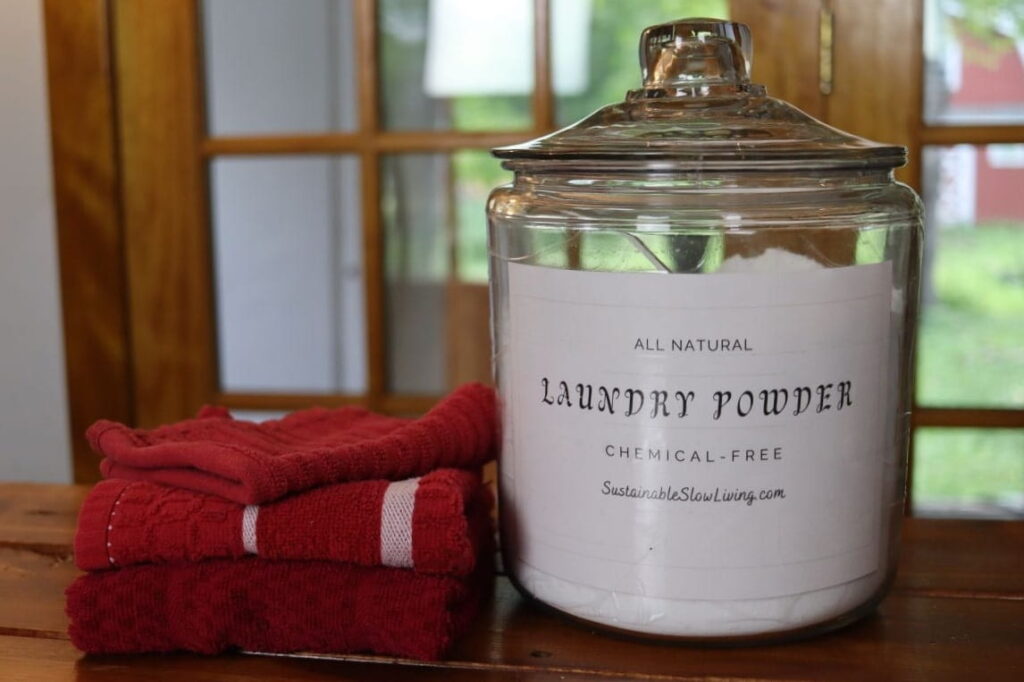

YT just “recommended” your video on homemade dish soap. In that video, you commented that you don’t have glycerine/glycerol around the house and never use it. It kind-of surprised me to hear that coming from someone who’s into DIY, more-natural alternatives. A very simple and effective hand “lotion” can be made by mixing 1 part (vegetable) glycerin with 1 to 2 parts (distilled) water. I use that for dry skin, and if it’s really bad, after I rub the glycerin mixture in, I’ll rub in a tiny bit of coconut oil over the top of it.
Sounds like a simple and useful way to remedy dry skin. Thank you for sharing it with me.
Thx for a recipe without Sal Suds, Castille, essential oils, or any of the other additives – for simple dish soap! I have a dishwasher that I use a lot, but like to wash items in between when I’m using them. I also really liked your explanation as to why “bubbles” aren’t necessary! Awesome – thx again!
So very welcome Cyndi. It’s great to keep it simple sometimes 😉
would you be able to make a recipe for your chemical free bar soaps?
Perhaps one day Caitlyn. Right now I am not making any soap using lye because I’m not living in my own space. It’s a messy business and the lye can easily cause damage to surfaces if you accidently get it on anything. Thanks so much for asking though. There are so many sources for soap making instructions online. Simply google ‘how to make soap with lye’.
Hi DianeGail! I followed your instructions and my solution solidified after cooling. Is this expected?
Hello! It will become a thick gel and will need to be shaken before each use. It should not become completely solid.
Hi there! Can this dish soap be used in a dishwasher? DO you have a dishwashing detergent recipe?
Hello! No, I don’t think this dish soap would work in a dishwasher. I don’t have a recipe for detergent for a dishwasher. I haven’t had one for so many years that I’ve never experimented with recipes for one.
Mine looks like cottage cheese…lol. What did I do wrong?
The soap must not have melted all the way. Maybe it wasn’t grated finely enough. I’m not sure how well it will work but I would try to heat it again and melt the soap more thoroughly.
It works well on everything, except plastics. I am slowly replacing the plastics in my kitchen, but for now, it doesn’t work on them. I added a good splash of white vinegar to the sink, and that helped.
I agree that it is not always as efficient on plastics. I find it works unless they are greasy.
On the note about essential oils, I was wondering if you were trying to scent/color your dish washing liquid, instead of using water could you use herbal “tea” like lavender or hibiscus in place of the water so it has a scent & light color?
I don’t see why you couldn’t do that. It’s worth a try 😉
Could I use castille soap in my DIY dish soap?
Yes. You can use castile soap as dish soap if you like. It’s just a bit expensive.
Thank you!
You’re very welcome!
What kind of handmade bar soap would you use in place of the ivory soap? A bar made of coconut oil? Olive oil? A mix? Or does it not really matter
I imagine there is some difference. But I’ve used many different types and I’ve always been happy with the results. I would use what was most readily available to me.
How much of the soap do you use with your dishes?
Also mine didn’t become a gel – it just forms a plug on top of mostly liquid underneath. Is that a problem?
Thanks!
How much you use will depend on the type of food residue on your dishes. You’ll have to experiment and kind of find your feet on this one.
The soap will resolidify to a point. It will need to be shaken well each time you use it. It should not form a plug. That sounds like a solid piece to me.
This is not a gel. To make that type of soap you have to follow a saponification process. This soap is for those who want to avoid that process.
It is not difficult but it uses a powerful chemical that must be worked with very carefully. It is the only way that soap as we know it, in bar or liquid form, can be made.
Oh, and I just realized your video says 2 tablespoons of baking soda, but the recipe says 1. Which is it? Thanks!
Hi Katie,
Thanks for bringing that to my attention. I’ll be honest when I make this dish soap I really don’t measure the baking soda. You can play around with this measurement and see what works for you. I tend to use closer to 2 tablespoons when I make it.
This homemade dish soap is such a great option for anyone looking to avoid working with lye! It’s simple, effective, and a great addition to a natural cleaning routine. If you give it a try, I’d love to hear how it worked for you! Drop a comment below to share or ask any questions — I’m always happy to help!